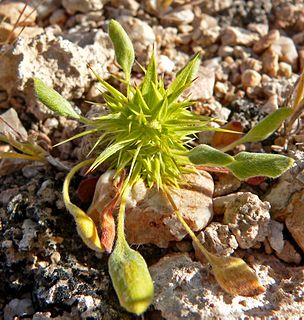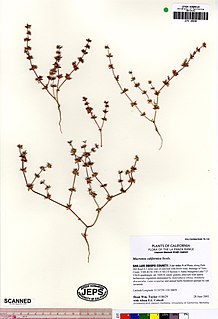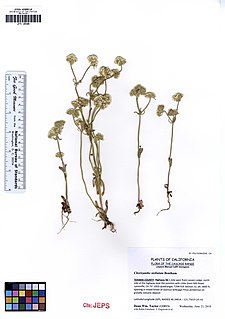
Chorizanthe is a genus of plants in the buckwheat family known generally as spineflowers. These are small, squat, herbaceous plants with spiny-looking inflorescences of flowers. The flowers may be in shades of red or yellow to white. The bracts are pointed and sometimes tipped with a hooked awn, and the inflorescence often dries into a rounded, spiny husk. Spineflowers are found in western North America and South America.

Mucronea is a genus of plants in the family Polygonaceae with two species restricted to California. Known generally as spineflowers, they are closely related to genus Chorizanthe. They are annual herbs producing slender, erect, glandular stems from taproots. The leaves are located around the base of the stem and wither quickly. The inflorescence is an open array of flowers, each blooming in an involucre of spiny bracts lined with awn-tipped teeth. The six-lobed flowers are white to pink.

Chorizanthe parryi is a species of flowering plant in the buckwheat family known by the common name Parry's spineflower and San Bernardino spineflower.
Chorizanthe angustifolia is a species of flowering plant in the buckwheat family known by the common name narrowleaf spineflower.
Chorizanthe blakleyi is a rare species of flowering plant in the buckwheat family known by the common name Blakley's spineflower. It is endemic to the Sierra Madre Mountains of Santa Barbara County, California, where it is known from only eight occurrences, four of which are within the bounds of the Los Padres National Forest. It grows only on north-facing slopes in chaparral and woodland habitat. This plant grows upright to no more than 15 centimeters tall. It is yellow-green and hairy, with a few basal leaves up to about 2 centimeters long. The inflorescence contains several flowers, each surrounded by a tube of six hairy bracts with straight or hooked awns. The flower is a few millimeters wide with white or pink deeply notched tepals.
Chorizanthe breweri is a rare species of flowering plant in the buckwheat family known by the common names San Luis Obispo spineflower and Brewer's spineflower. It is endemic to California, where it is known from about twenty occurrences in the Central Coast Ranges of San Luis Obispo and far southern Monterey Counties. It grows in the chaparral and woodlands of the range, generally on serpentine soils. This small plant produces decumbent stems extending along the ground and sometimes growing upright to a maximum length of about half a meter. The herbage is mostly reddish in color and somewhat hairy. The inflorescence is a cluster of flowers, each surrounded by six hairy reddish bracts with hooked tips. The flower itself is only about 3 millimeters wide and is white to red and hairy.

Chorizanthe corrugata is a species of flowering plant in the buckwheat family known by the common name wrinkled spineflower. It is native to the Mojave and Sonoran Deserts of the southwestern United States and two states of northwest Mexico, Baja California and Sonora.

Chorizanthe cuspidata is a species of flowering plant in the buckwheat family known by the common name San Francisco spineflower. It is endemic to California, where it is known only from the San Francisco Bay Area and to the immediate north and south. It grows in sandy coastal habitat.
Chorizanthe diffusa is a species of flowering plant in the buckwheat family known by the common name diffuse spineflower. It is endemic to California, where it grows on the coastline and mountains of the Central Coast, in sandy scrub, woodland, and forest habitat. It is erect to prostrate in form, its stem generally no longer than 15 or 20 centimeters. The leaves are up to 2 centimeters long and mainly arranged about the base of the plant. The inflorescence is a cluster of flowers, each surrounded by six hook-tipped bracts. The margins of the bracts proximal to the long hooked tip may be very thin and nearly invisible to wide and obvious, and they may be green to white to purplish. The flower itself is about 3 millimeters wide and white with a yellow throat. The tips of its tepals may be smooth or jagged or toothed.

Chorizanthe douglasii is a species of flowering plant in the buckwheat family known by the common names San Benito spineflower and Douglas' spineflower. It is endemic to California, where it grows in the mountains of the Southern California Coast Ranges, from the Santa Lucia Range east to the Gabilan Range.
Chorizanthe howellii is a species of flowering plant in the buckwheat family known by the common names Mendocino spineflower and Howell's spineflower. It is endemic to coastal Mendocino County, California, where it is known only from the sand dunes and coastal scrub near Fort Bragg. It is estimated that 95% of the remaining individuals of this plant are part of a single population growing at MacKerricher State Park. It is a federally listed endangered species.
Chorizanthe leptotheca is a species of flowering plant in the buckwheat family known by the common names Ramona spineflower and Peninsular spineflower. It is native to the Peninsular Ranges of southern California and Baja California, where it grows in chaparral and forest habitat. It is very similar to its close relative, Turkish rugging.
Chorizanthe palmeri is a species of flowering plant in the buckwheat family known by the common name Palmer's spineflower. It is endemic to California, where it is known only from the Central Coast Ranges of western Monterey and San Luis Obispo Counties.

Chorizanthe pungens is a species of flowering plant in the buckwheat family known by the common name Monterey spineflower. It is endemic to California, where it is known from the San Francisco Bay Area south along the Central Coast.
Chorizanthe rectispina is a species of flowering plant in the buckwheat family known by the common names prickly spineflower and straight-awned spineflower. It is endemic to California, where it is known from about twenty occurrences from Monterey to Santa Barbara Counties. It grows in dry habitat types such as chaparral and woodland in the hills of the Central Coast Ranges. It is a low, spreading plant with stems up to about 25 centimeters long, grayish to greenish in color and hairy in texture. The inflorescence is a cluster of flowers, each flower surrounded by six hairy bracts which are grayish to pink in color and tipped with awns. One bract is longer than the others and has a straight awn, and the other smaller bracts may have hooked awns. The tiny flower at the center of the bract array is a few millimeters wide and white and yellow in color.

Chorizanthe robusta is a species of flowering plant in the buckwheat family. It is endemic to California, where it is a rare, federally listed endangered species.
Chorizanthe spinosa is an uncommon species of flowering plant in the buckwheat family known by the common name Mojave spineflower. It is endemic to California, where it is known only from the scrub habitat at the western edges of the Mojave Desert.

Chorizanthe stellulata is a species of flowering plant in the buckwheat family known by the common name starlet spineflower. It is endemic to California, where it grows in the dry woodlands of the low mountains and foothills along the central part of the state, such as the Sierra Nevada foothills. The plant takes an erect form, reaching up to 30 centimeters tall. The leaves are located at the base of the plant, and there is also a whorl of leaves at mid-stem. The inflorescence is a dense cluster of flowers, each flower surrounded by hairy, bristly white bracts tipped with hooked awns. The flower is 4 or 5 millimeters long and white to pink in color.
Chorizanthe uniaristata is a species of flowering plant in the buckwheat family known by the common name one-awn spineflower. It is endemic to central California, where it is known from several of the local mountain ranges, as well as the Central Coast.

Chorizanthe xanti is a species of flowering plant in the buckwheat family known by the common name Riverside spineflower. It is endemic to California, where it grows in several of the mountain ranges from the Sierra Nevada to the Southern California Transverse Ranges in forest, woodland, and scrub habitats.










